You’re about to discover why pothos plants have become the go-to choice for indoor gardening enthusiasts. These versatile climbers adapt to various light conditions and come in stunning varieties, from the classic Golden Pothos with its yellow-streaked leaves to the eye-catching Neon Pothos that glows like nature’s nightlight. Whether you’re a novice or seasoned plant parent, there’s a pothos variety that’ll match your style and skill level.
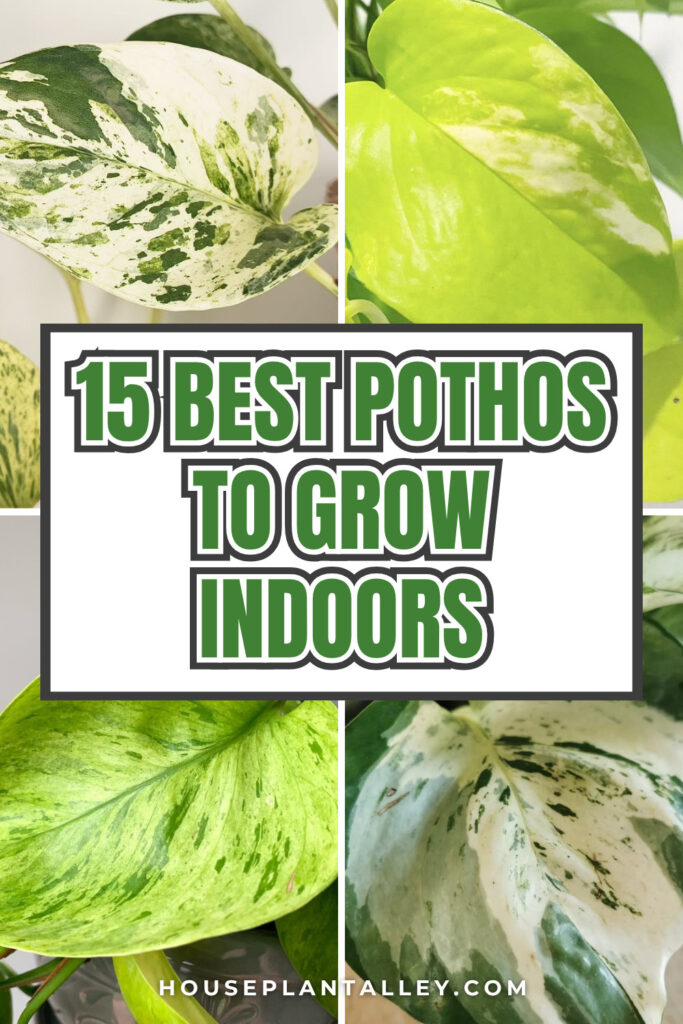
Contents
- 1 1. Golden Pothos
- 2 2. Jade Pothos
- 3 3. Marble Queen Pothos
- 4 4. Neon Pothos
- 5 5. Satin Pothos
- 6 6. Jessenia Pothos
- 7 7. N’Joy Pothos
- 8 8. Silvery Ann Pothos
- 9 9. Pearls and Jade Pothos
- 10 10. Cebu Blue Pothos
- 11 11. Manjula Pothos
- 12 12. Hawaiian Pothos
- 13 13. Global Green Pothos
- 14 14. Snow Queen Pothos
- 15 15. Baltic Blue Pothos
- 16 16. Harlequin Pothos
- 17 17. Trebi Pothos
- 18 18. Glacier Pothos
- 19 19. Shangri-La Pothos
1. Golden Pothos
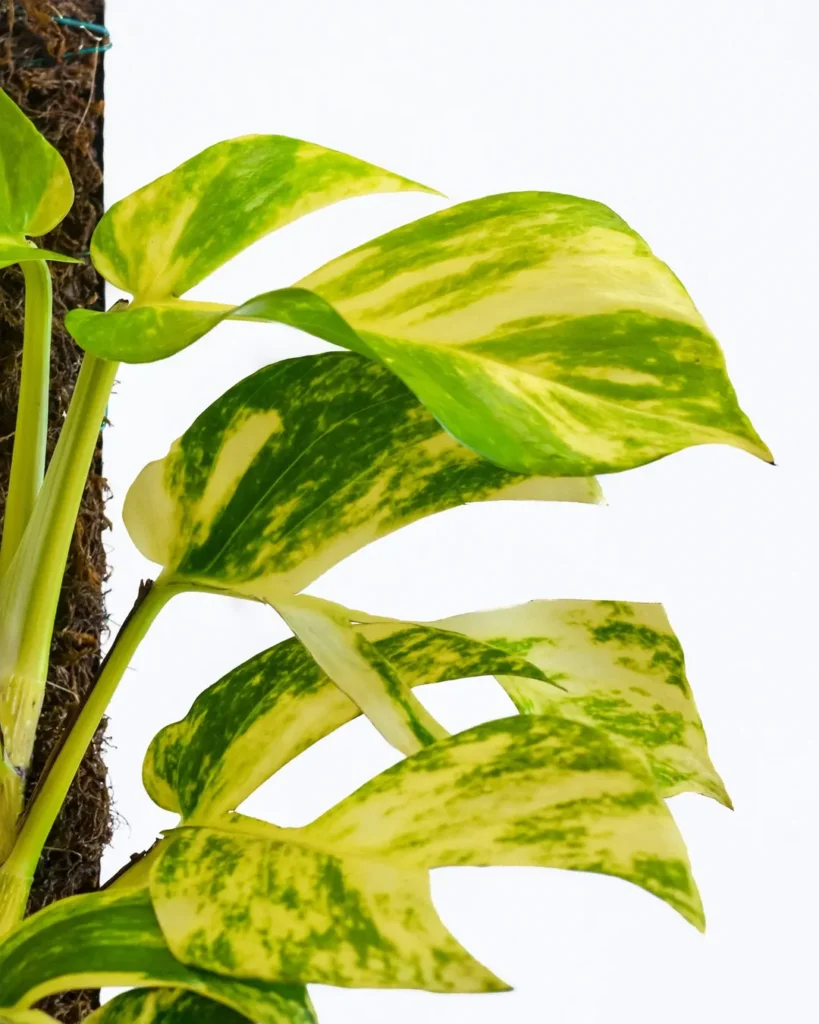
Golden Pothos (Epipremnum aureum) is one of the most popular and widely grown pothos varieties, known for its heart-shaped leaves featuring vibrant golden-yellow variegation against green backgrounds. This hardy vine can grow up to 40 feet in natural conditions but remains manageable indoors, making it perfect for hanging baskets or climbing supports. Its air-purifying qualities and adaptability to various indoor environments have earned it the nickname “Devil’s Ivy,” as it’s remarkably difficult to kill.
- Light: Thrives in bright, indirect light but tolerates low-light conditions; avoid direct sunlight which can burn leaves
- Water: Allow top 1-2 inches of soil to dry between waterings; water less frequently in winter
- Soil: Well-draining potting mix rich in organic matter
- Humidity: Adapts to average household humidity but prefers higher levels
- Temperature: Comfortable in normal room temperatures between 60-80°F (15-27°C)
- Fertilizer: Feed monthly with balanced liquid fertilizer during growing season
- Container: Any well-draining pot with drainage holes
- Pruning: Trim regularly to maintain desired shape and promote bushier growth
2. Jade Pothos
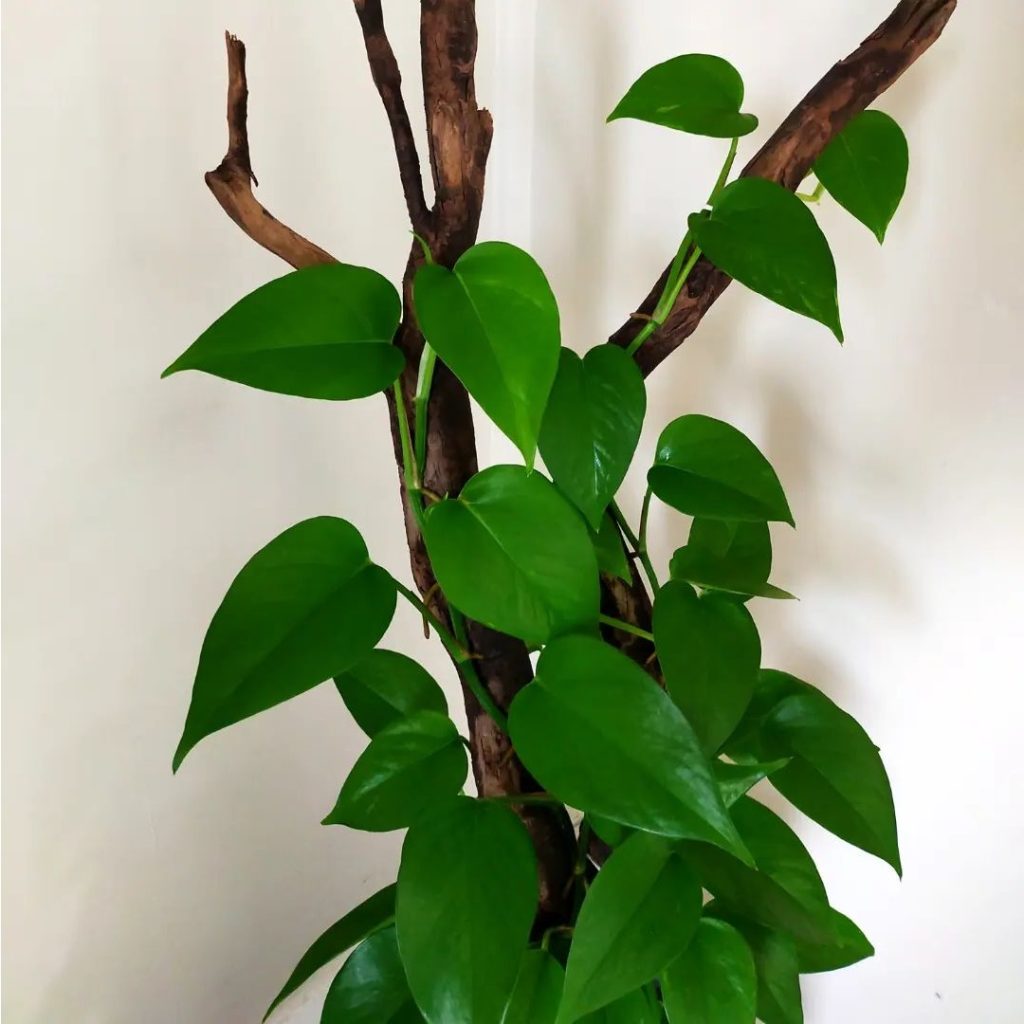
Jade Pothos is a striking variety known for its solid, deep green leaves that have a glossy finish. Unlike other pothos varieties that feature variegation, Jade Pothos maintains a uniform color throughout its foliage. The heart-shaped leaves are typically smaller than those of other pothos varieties, but they grow abundantly on vining stems that can reach impressive lengths when properly maintained. This variety is particularly valued for its hardiness and ability to thrive in various indoor conditions.
- Light: Tolerates low to bright indirect light; avoid direct sunlight which can burn leaves; grows best in moderate to bright indirect light
- Water: Allow top 1-2 inches of soil to dry between waterings; water less frequently in winter
- Soil: Well-draining potting mix rich in organic matter
- Humidity: Adaptable to normal household humidity levels; benefits from occasional misting
- Temperature: Thrives in temperatures between 60-80°F (15-27°C)
- Fertilizer: Feed monthly during growing season with balanced liquid fertilizer
- Container: Any well-draining pot with drainage holes; can be grown in hanging baskets
3. Marble Queen Pothos
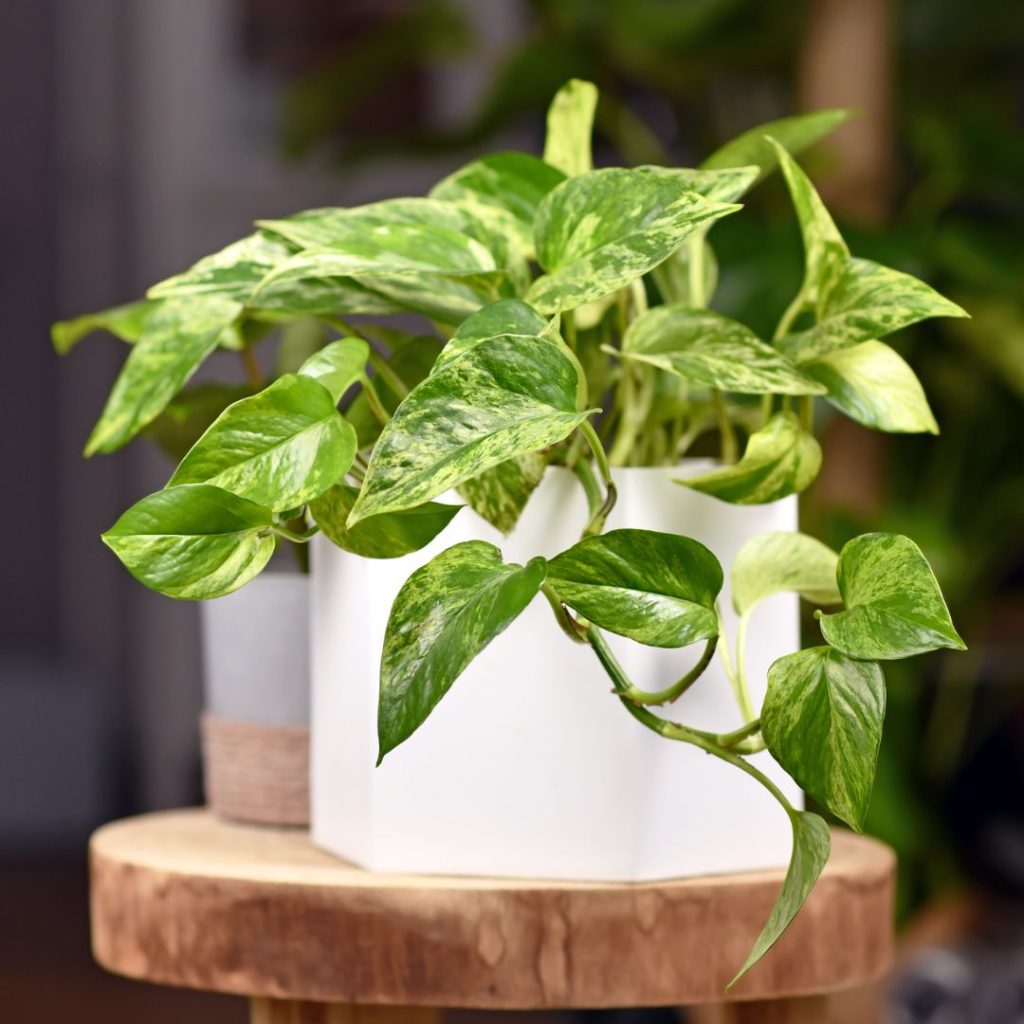
The Marble Queen Pothos is a striking variety known for its heavily variegated foliage featuring a mix of cream-white and green colors in a marbled pattern. This slower-growing cultivar of Epipremnum aureum produces heart-shaped leaves that are smaller than those of the standard golden pothos, and its vines can reach lengths of 10 feet or more when grown indoors. The distinctive variegation pattern makes it a popular choice for hanging baskets, shelves, or climbing supports.
- Light: Bright, indirect light; can tolerate medium light but may lose variegation in low light conditions
- Water: Allow top 1-2 inches of soil to dry between waterings; reduce watering in winter
- Soil: Well-draining potting mix rich in organic matter
- Humidity: Tolerates average household humidity but prefers 50-70%
- Temperature: 60-80°F (15-27°C)
- Fertilizer: Feed monthly during growing season with balanced liquid fertilizer
- Container: Use pot with drainage holes to prevent root rot
- Pruning: Trim regularly to maintain desired shape and promote bushier growth
4. Neon Pothos
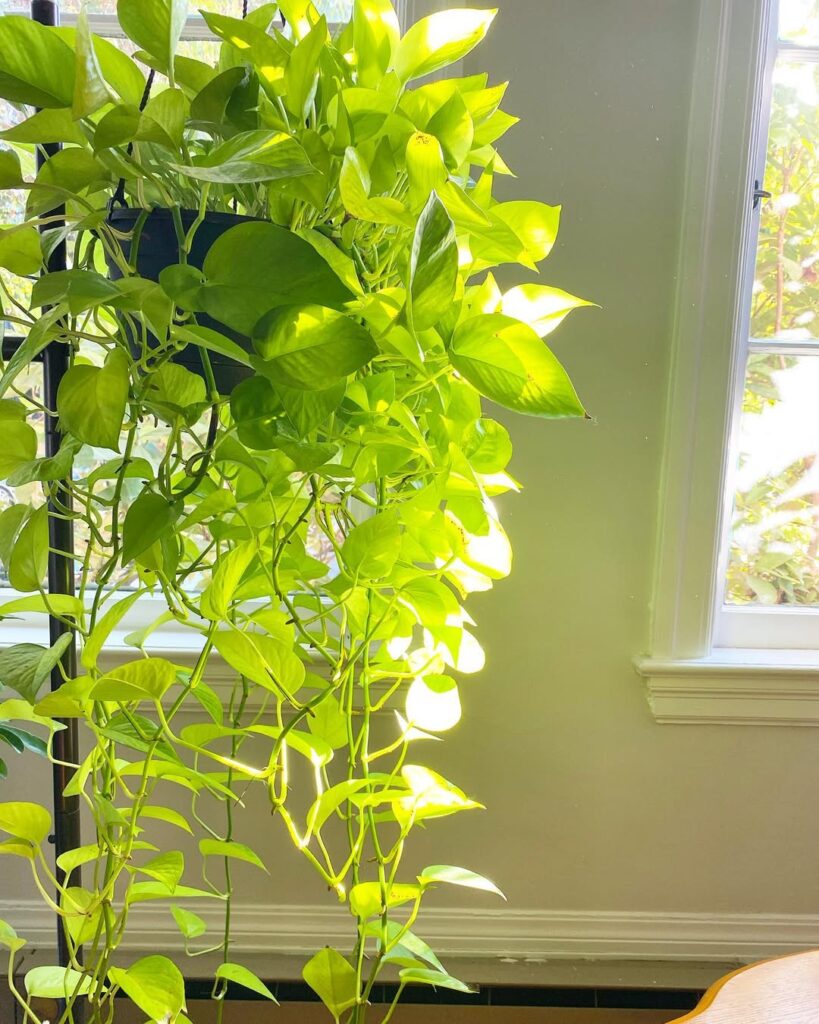
Neon Pothos is a striking cultivar of Epipremnum aureum characterized by its vibrant chartreuse-yellow leaves. This eye-catching variety maintains its bright color throughout its life cycle and does not feature variegation like other pothos varieties. The leaves are heart-shaped and glossy, creating a dramatic display when grown as a hanging plant or trained to climb. Despite its bold appearance, Neon Pothos is just as hardy and easy to grow as other pothos varieties.
- Light: Bright, indirect light is ideal; can tolerate medium light but may lose some color intensity in low light conditions
- Water: Allow top 1-2 inches of soil to dry between waterings; water less in winter
- Soil: Well-draining potting mix rich in organic matter
- Temperature: 60-80°F (15-27°C)
- Humidity: Tolerates average household humidity but thrives in higher humidity
- Fertilizer: Feed monthly during growing season with balanced liquid fertilizer
- Container: Any pot with drainage holes; plastic or ceramic both work well
5. Satin Pothos
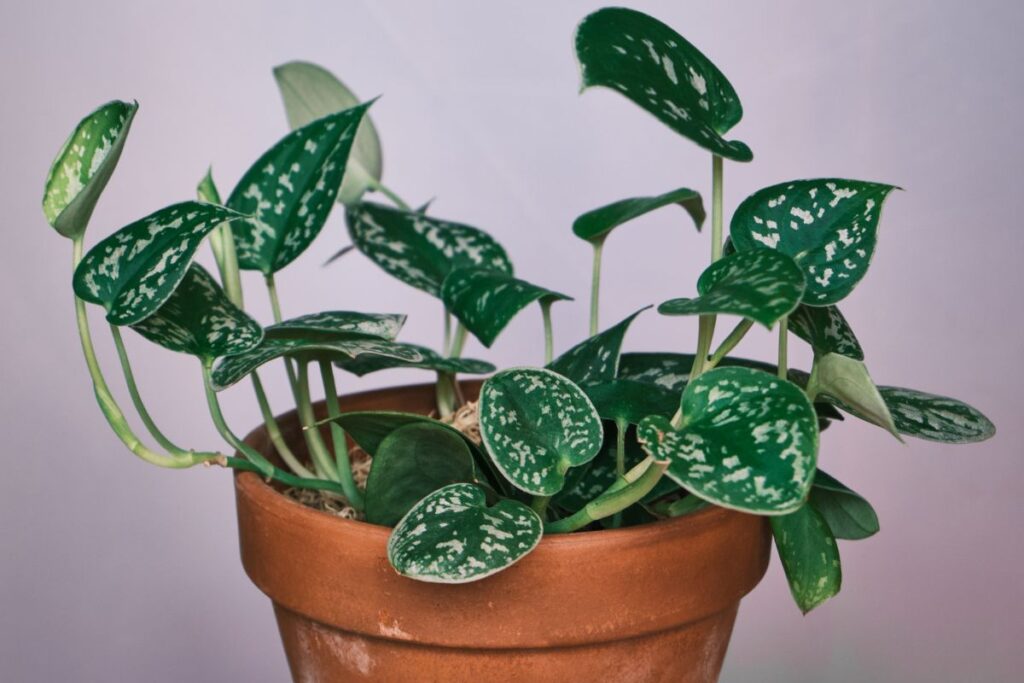
Satin Pothos (Scindapsus pictus) is a popular trailing vine known for its distinctive heart-shaped leaves with silvery variegation that creates a satin-like sheen. Despite its common name, it’s not actually a true pothos but rather belongs to the Scindapsus genus. The plant’s velvety foliage features dark green leaves splashed with silver spots and markings, making it an attractive choice for hanging baskets or climbing up moss poles.
- Light: Bright indirect light; can tolerate medium light but avoid direct sun
- Water: Allow top 2-3 inches of soil to dry between waterings; reduce watering in winter
- Soil: Well-draining, rich potting mix with peat moss and perlite
- Humidity: Prefers high humidity (50-60%); mist regularly or use a humidity tray
- Temperature: 65-85°F (18-29°C)
- Fertilizer: Feed monthly during growing season with balanced liquid fertilizer
- Container: Use pot with drainage holes; repot every 2-3 years
- Support: Provide trellis or moss pole for climbing growth
6. Jessenia Pothos
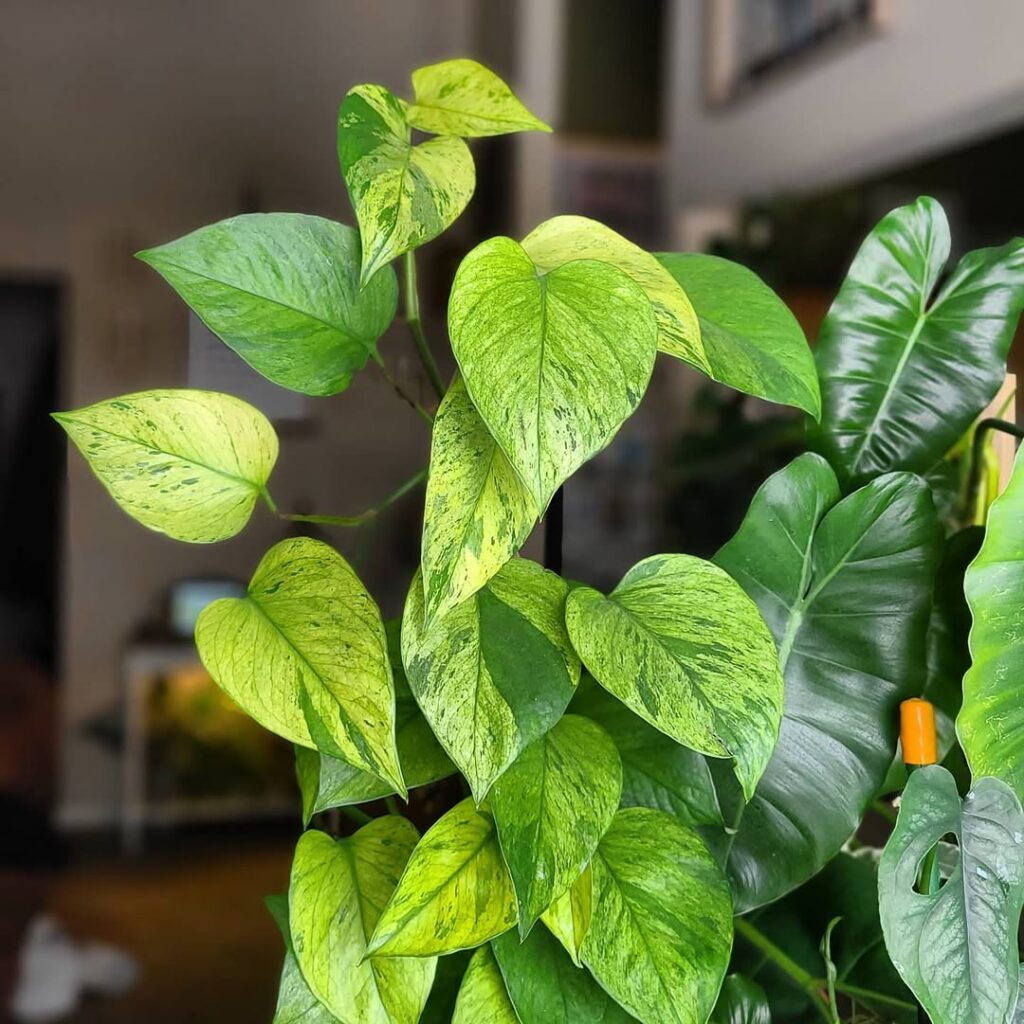
Jessenia Pothos is a striking variegated cultivar featuring lime green and darker forest green marbling patterns on its heart-shaped leaves. This rare variety maintains its distinctive coloring regardless of light conditions, unlike some other variegated pothos that may revert. While it grows more slowly than common pothos varieties, Jessenia develops into a lush, trailing plant that can reach several feet in length when properly maintained.
- Light: Bright to medium indirect light; avoid direct sunlight which can burn leaves; more light promotes better variegation
- Water: Allow top 1-2 inches of soil to dry between waterings; reduce watering in winter
- Soil: Well-draining potting mix rich in organic matter
- Humidity: Tolerates average household humidity but thrives in higher humidity levels
- Temperature: 60-80°F (15-27°C)
- Fertilizer: Monthly feeding with balanced liquid fertilizer during growing season
- Container: Use pot with drainage holes to prevent root rot
- Pruning: Trim leggy vines to promote fuller growth
7. N’Joy Pothos
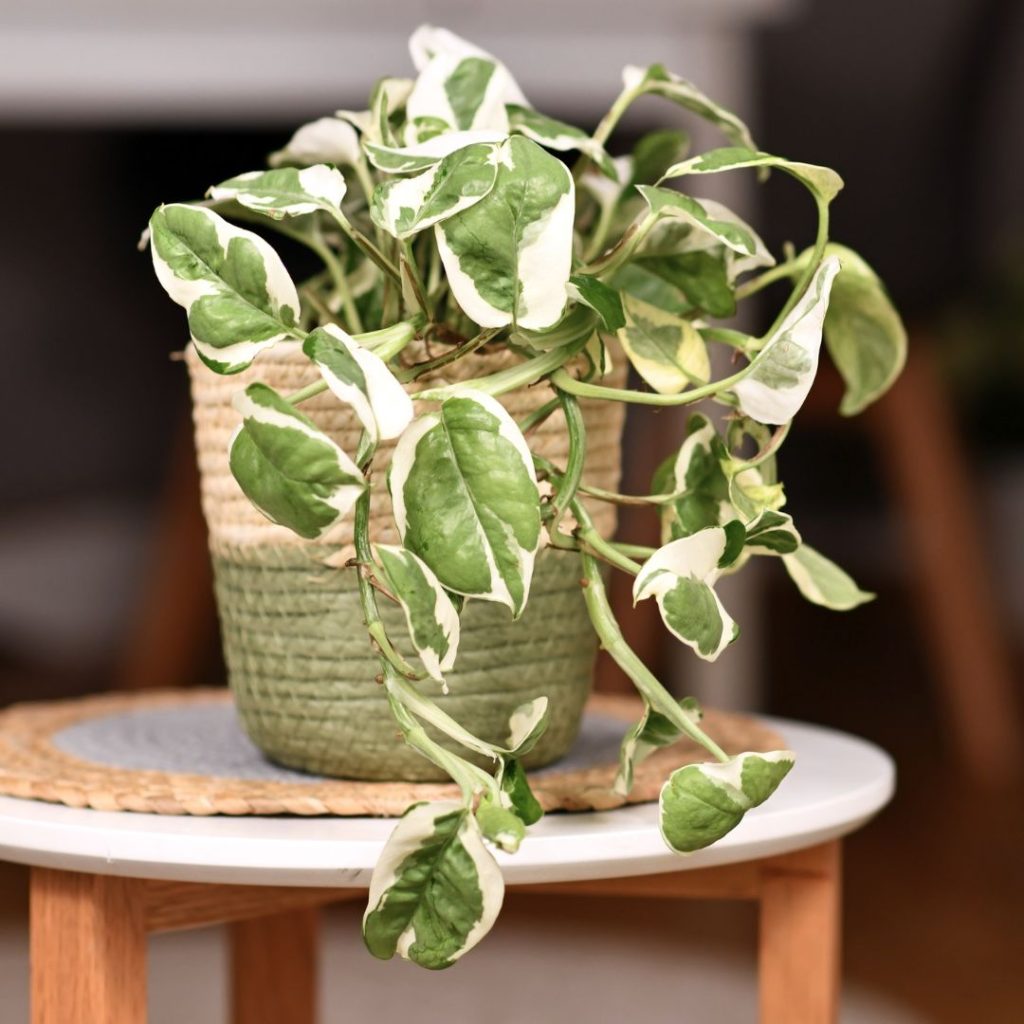
N’Joy Pothos is a striking variegated cultivar featuring small, heart-shaped leaves with crisp white and dark green patches. This compact variety grows more slowly and produces smaller foliage than other pothos types, making it ideal for small spaces and hanging baskets. The variegation pattern is quite stable, with sharp, distinct boundaries between the white and green areas, unlike the more mottled appearance of other variegated pothos varieties.
- Light: Bright indirect light; avoid direct sunlight which can burn leaves; tolerates medium light but may lose variegation in low light
- Water: Allow top 1-2 inches of soil to dry between waterings; reduce watering in winter
- Soil: Well-draining potting mix rich in organic matter
- Humidity: Moderate to high humidity (50-70%); mist occasionally
- Temperature: 60-80°F (15-27°C)
- Fertilizer: Balanced liquid fertilizer every 4-6 weeks during growing season
- Container: Any well-draining pot with drainage holes
- Growth Pattern: Compact and slower growing compared to other pothos varieties
8. Silvery Ann Pothos
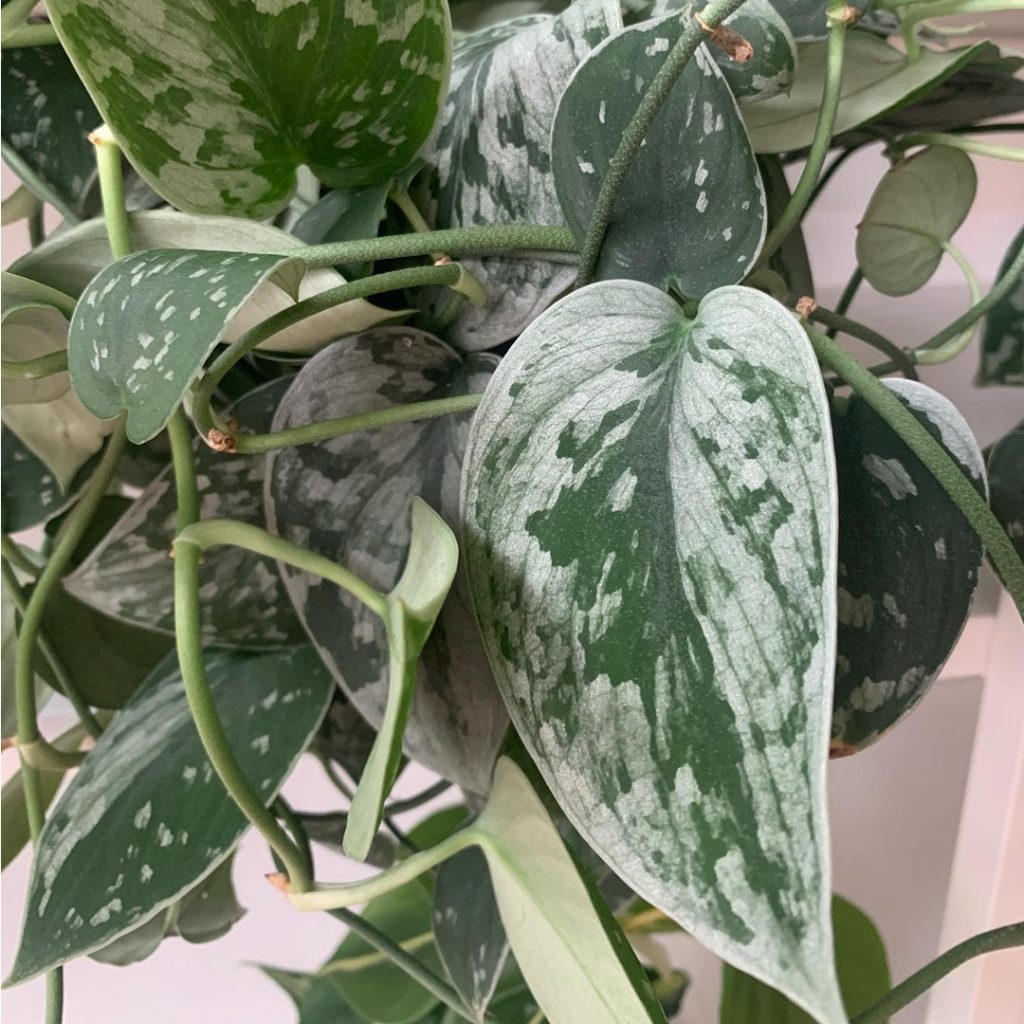
Silvery Ann Pothos is a striking variegated cultivar of Epipremnum aureum, featuring green leaves splashed with silvery-white markings that can cover up to 50% of each leaf. This variety is known for its medium-sized, heart-shaped foliage and trailing vines that can grow several feet long when properly maintained. The variegation pattern is similar to its cousin, the Satin Pothos, but tends to be more dramatic and irregular in its distribution.
- Light: Bright, indirect light; can tolerate medium light but may lose variegation in low light conditions
- Water: Allow top 1-2 inches of soil to dry between waterings; reduce watering in winter
- Soil: Well-draining, airy potting mix with peat moss and perlite
- Humidity: Tolerates average household humidity but thrives in 50-60%
- Temperature: 60-80°F (15-27°C)
- Fertilizer: Balanced liquid fertilizer every 4-6 weeks during growing season
- Pot Type: Container with drainage holes
- Propagation: Easy to propagate through stem cuttings in water or soil
9. Pearls and Jade Pothos
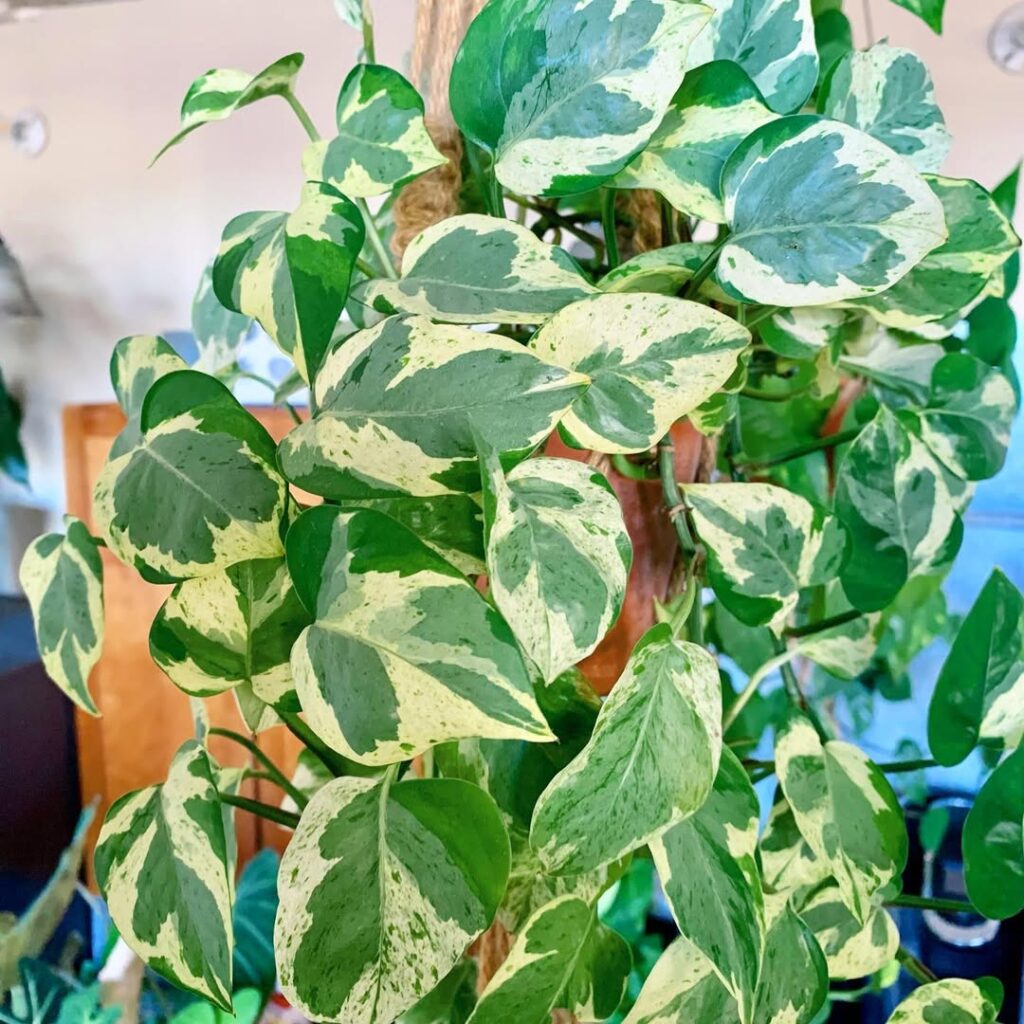
Pearls and Jade Pothos is a patented variety characterized by its compact growth and striking variegated foliage. The leaves feature an intricate mix of green, gray-green, and white patches, creating a marbled appearance that makes it highly ornamental. This slow-growing cultivar maintains a bushier form compared to other pothos varieties, with smaller leaves that typically reach 2-3 inches in length. Its variegation pattern is stable and consistent, making it a reliable choice for indoor decoration.
- Light: Bright, indirect light; can tolerate medium light but may lose variegation in low light conditions
- Water: Allow top 1-2 inches of soil to dry between waterings; reduce watering in winter
- Soil: Well-draining potting mix rich in organic matter
- Humidity: Tolerates average household humidity but thrives in higher humidity
- Temperature: 60-80°F (15-27°C)
- Fertilizer: Feed monthly during growing season with balanced liquid fertilizer
- Container: Any well-draining pot with drainage holes
- Pruning: Trim occasionally to maintain shape and remove yellowed leaves
10. Cebu Blue Pothos
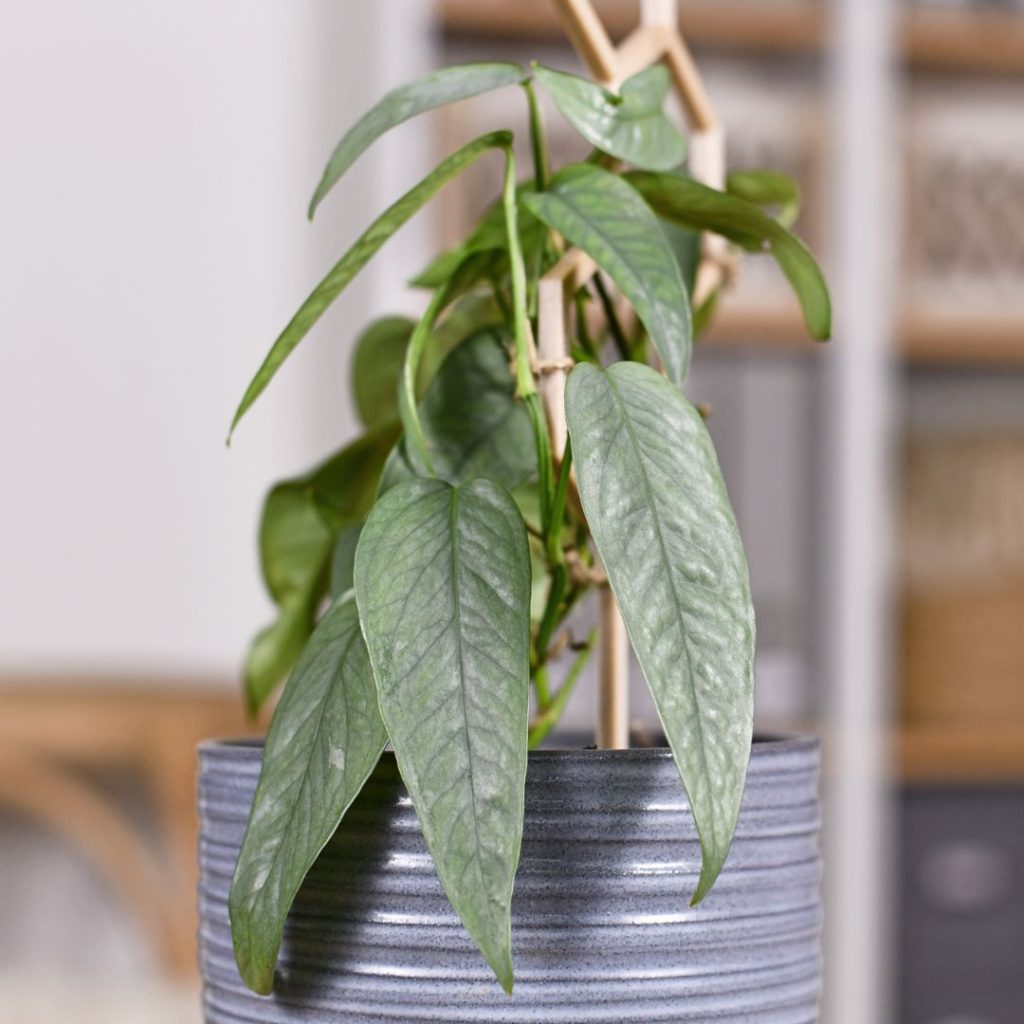
Cebu Blue Pothos (Epipremnum pinnatum) is a striking climbing vine featuring slender, silvery-blue leaves with a metallic sheen. Unlike other pothos varieties, its foliage is narrower and more elongated, developing deep splits and fenestrations as the plant matures. Native to Southeast Asia, this pothos variety is known for its vigorous growth and can reach impressive lengths when given proper support, making it an excellent choice for hanging baskets or climbing poles.
- Light: Bright, indirect light; can tolerate medium light but may lose bluish tint in low light conditions
- Water: Allow top 2-3 inches of soil to dry between waterings; reduce watering in winter
- Soil: Well-draining, airy potting mix with peat moss and perlite
- Humidity: Thrives in 50-60% humidity; tolerates average household humidity
- Temperature: 65-85°F (18-29°C)
- Fertilization: Feed monthly during growing season with balanced liquid fertilizer
- Support: Benefits from moss poles or trellises to encourage mature leaf development
11. Manjula Pothos
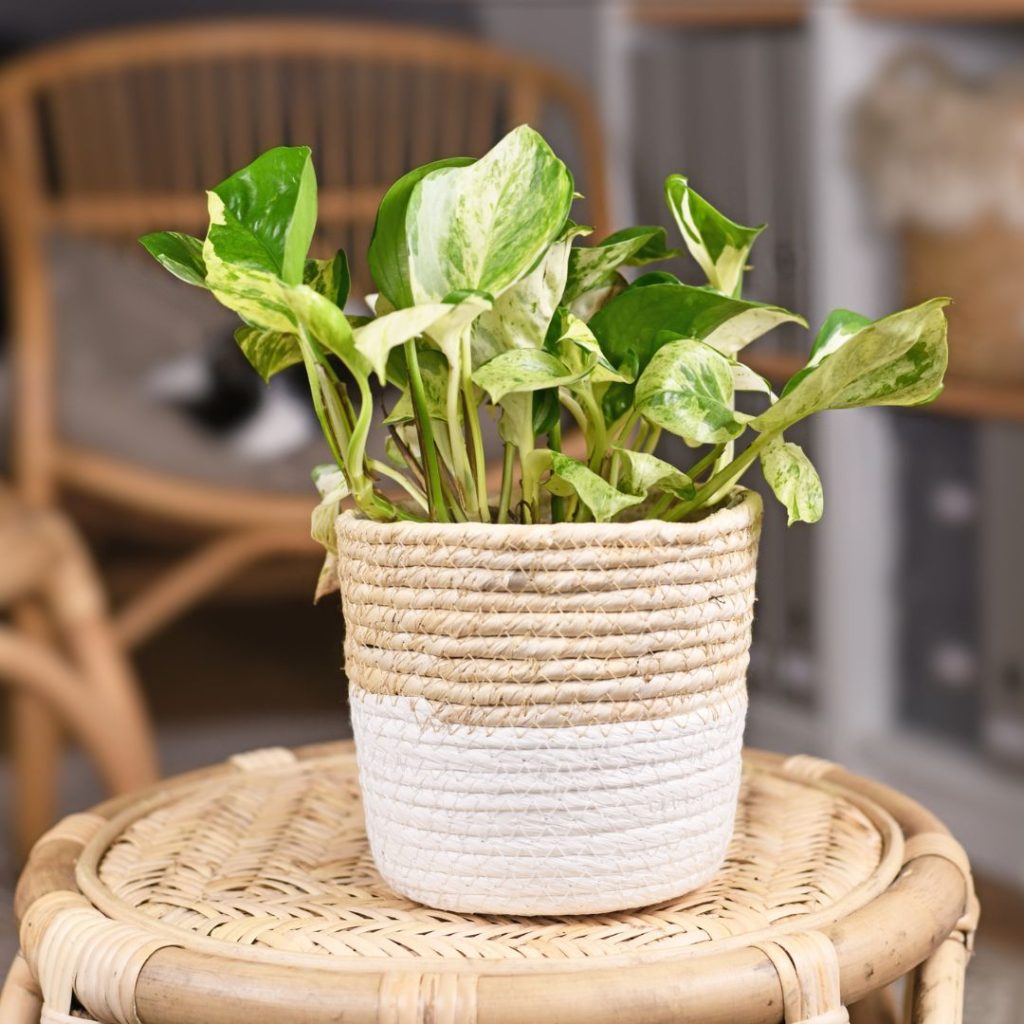
Manjula Pothos is a patented variety of pothos known for its distinctive variegated foliage featuring creamy white, silver, and various shades of green in swirled patterns. The leaves are broader and more heart-shaped than many other pothos varieties, with a slightly wavy texture that gives them a unique appearance. This rare cultivar grows at a moderate pace and maintains a compact, bushy form when properly maintained.
- Light: Bright, indirect light; can tolerate medium light but variegation may fade in low light conditions
- Water: Allow top 1-2 inches of soil to dry between waterings; reduce watering in winter
- Soil: Well-draining potting mix with good aeration; mix of peat, perlite, and regular potting soil
- Humidity: Moderate to high humidity (50-70%); mist regularly or use a humidity tray
- Temperature: 65-85°F (18-29°C)
- Fertilizer: Balanced liquid fertilizer every 4-6 weeks during growing season
- Pot: Container with drainage holes to prevent root rot
- Pruning: Regular trimming to maintain shape and remove yellowed leaves
12. Hawaiian Pothos
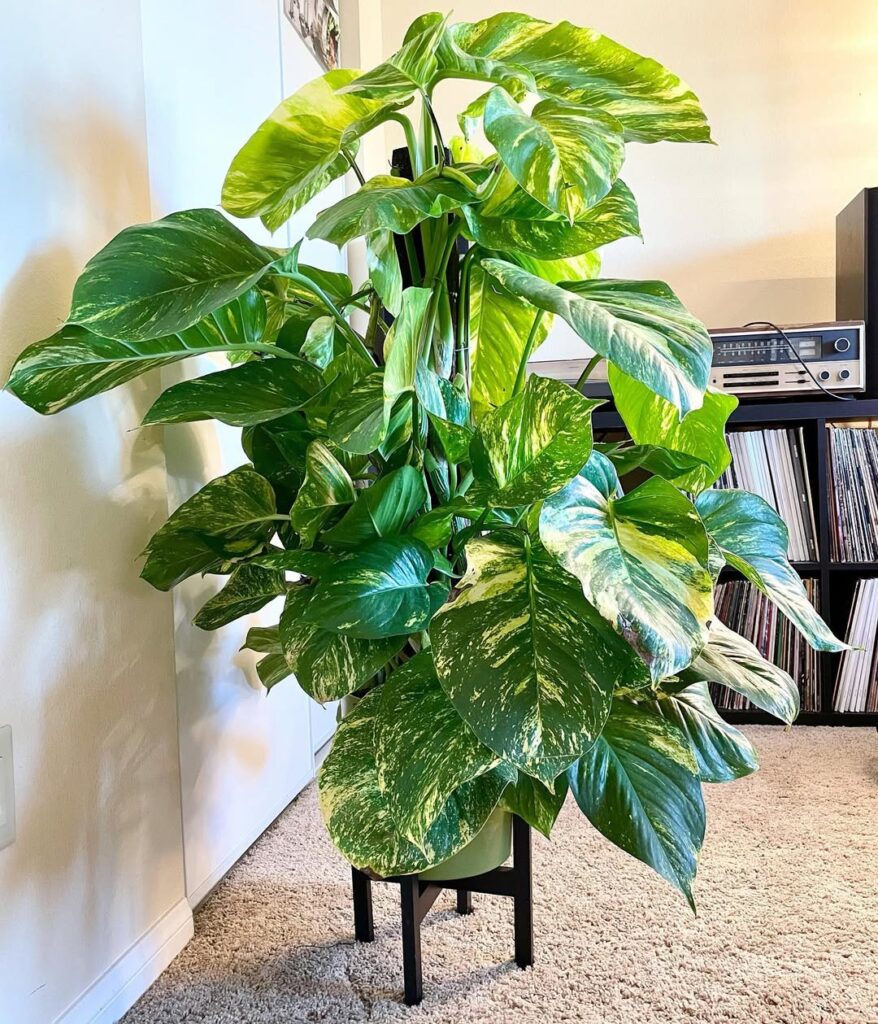
Hawaiian Pothos is a bright and cheerful variety featuring large, heart-shaped leaves with golden-yellow variegation against a medium green background. Often confused with Golden Pothos, Hawaiian Pothos typically has larger leaves and more pronounced yellow patches that can cover up to half of each leaf. This climbing vine is known for its vigorous growth and ability to produce impressive aerial roots, making it an excellent choice for trellises or allowing it to cascade from hanging baskets.
- Light: Bright to moderate indirect light; can tolerate lower light but may lose variegation
- Water: Allow top 1-2 inches of soil to dry between waterings; reduce watering in winter
- Soil: Well-draining potting mix rich in organic matter
- Humidity: Moderate to high humidity; tolerates average household humidity
- Temperature: 60-85°F (15-29°C)
- Fertilizer: Balanced liquid fertilizer every 4-6 weeks during growing season
- Container: Any well-draining pot with drainage holes
- Growth Pattern: Climbing or trailing, can reach lengths of 20-40 feet in ideal conditions
13. Global Green Pothos
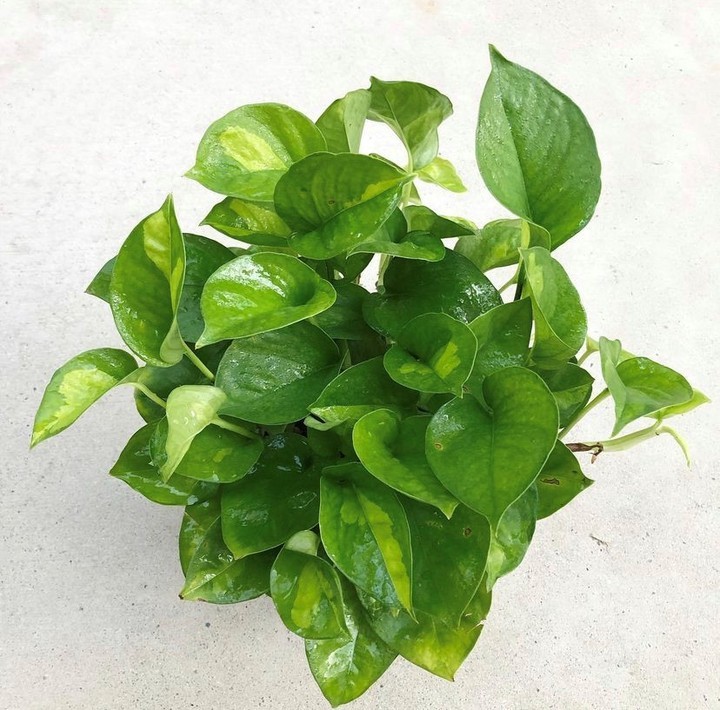
Global Green Pothos is a striking variety featuring large, heart-shaped leaves with a solid lime-green to dark green coloration. This cultivar lacks the typical variegation found in many other pothos varieties, instead displaying a uniform green shade that creates a lush, tropical appearance. Its vining stems can grow several feet long, making it an excellent choice for hanging baskets or training up support structures, while its robust nature makes it a reliable houseplant for both novice and experienced growers.
- Light: Bright to moderate indirect light; can tolerate lower light conditions but may grow slower; avoid direct sunlight
- Water: Allow top 1-2 inches of soil to dry between waterings; water less in winter months
- Soil: Well-draining potting mix rich in organic matter
- Humidity: Tolerates average household humidity but thrives in higher humidity
- Temperature: 60-80°F (15-27°C)
- Fertilizer: Monthly feeding during growing season with balanced houseplant fertilizer
- Potting: Use containers with drainage holes; repot every 2-3 years or when root-bound
14. Snow Queen Pothos
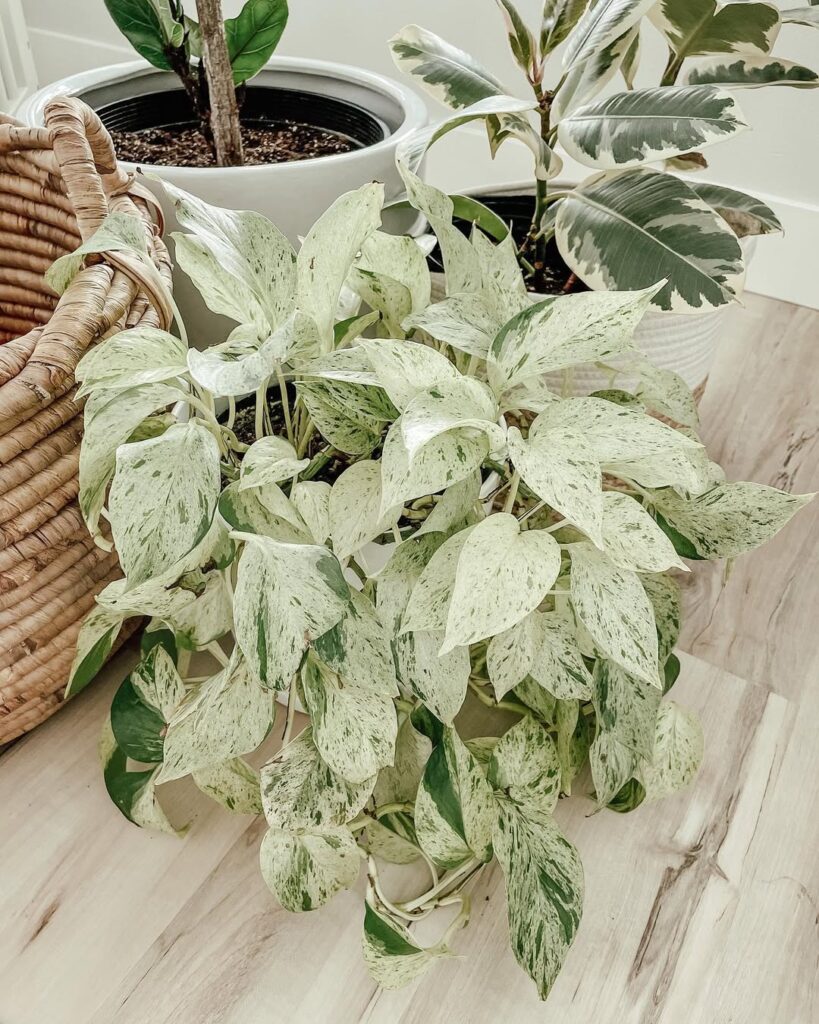
Snow Queen Pothos is a striking variegated cultivar of Epipremnum aureum, featuring heavily marbled white and green foliage that can brighten any indoor space. This variety is distinguished from other pothos types by its primarily white leaves with minimal green patches, though the amount of variegation can vary depending on light exposure. While slower-growing than other pothos varieties due to its reduced chlorophyll content, the Snow Queen maintains the same vining habit and adaptable nature of its relatives.
- Light: Bright, indirect light; some direct morning sun is tolerable; avoid harsh afternoon sun; insufficient light will cause loss of variegation
- Water: Allow top 1-2 inches of soil to dry between waterings; less frequent watering in winter; sensitive to overwatering
- Soil: Well-draining potting mix with added perlite; slightly acidic pH (6.1-6.5)
- Humidity: Tolerates average home humidity (40-60%); benefits from occasional misting
- Temperature: 60-80°F (15-27°C); protect from cold drafts
- Fertilizer: Light feeding with balanced fertilizer during growing season; reduce in winter
- Container: Any well-draining pot with drainage holes; can be grown in hanging baskets
15. Baltic Blue Pothos
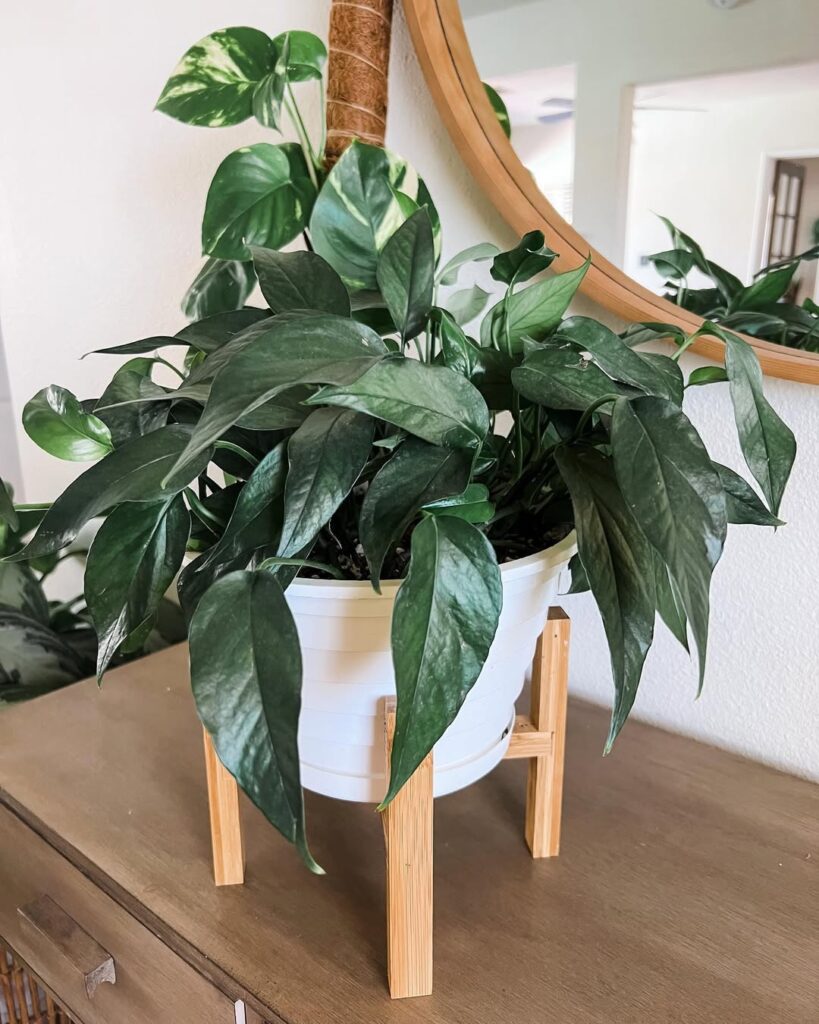
The Baltic Blue Pothos is a newer cultivar of Epipremnum pinnatum that has gained popularity among houseplant enthusiasts. This climbing variety features deep blue-green foliage with a matte finish and develops impressive fenestrations (splits) in its leaves as it matures. Similar to other pothos varieties, it can grow as a trailing plant or climb upward when given proper support, with leaves becoming larger and more dramatically split when allowed to climb.
- Light: Bright to moderate indirect light; can tolerate lower light conditions but may grow slower and develop fewer fenestrations
- Water: Allow top 1-2 inches of soil to dry between waterings; reduce watering in winter
- Soil: Well-draining potting mix with added perlite or orchid bark
- Humidity: Tolerates average household humidity but thrives in higher humidity levels (50-60%)
- Temperature: 65-85°F (18-29°C)
- Support: Provide moss pole or trellis for climbing and ideal leaf development
- Fertilizer: Monthly feeding during growing season with balanced houseplant fertilizer
Absolutely! Here are the additional pothos varieties formatted to match your blog style:
16. Harlequin Pothos
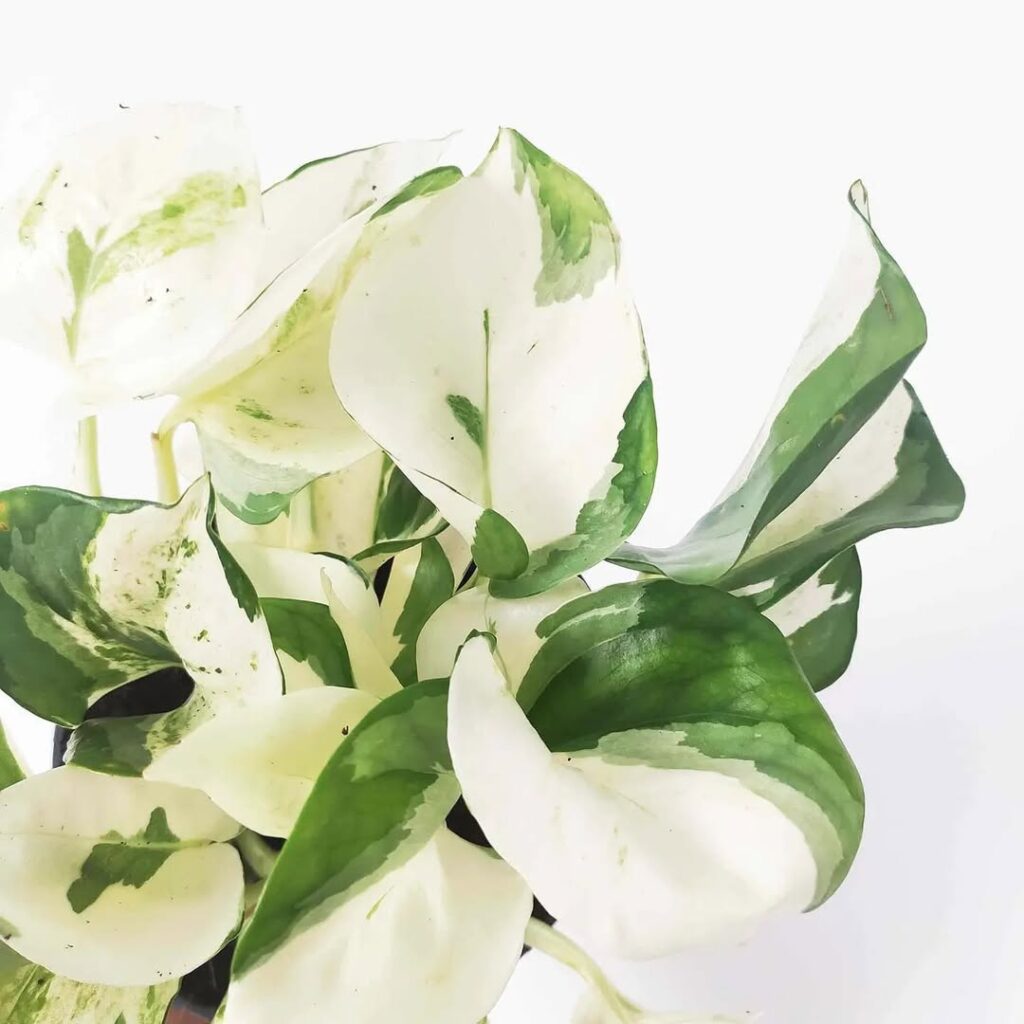
Harlequin Pothos is a rare variety similar to Manjula, but with even more intense variegation. Its creamy white and green foliage boasts unpredictable splashes, making each leaf unique. Like other pothos, it thrives in a range of indoor conditions and grows beautifully in hanging baskets or when trained to climb.
- Light: Bright indirect light for best variegation; can tolerate moderate indirect light
- Water: Allow top 1-2 inches of soil to dry before watering; avoid soggy soil
- Soil: Well-draining potting mix with added perlite
- Humidity: Average household humidity; enjoys occasional misting
- Temperature: 65-85°F (18-29°C)
- Support: Can climb if provided with a moss pole or trellis
- Fertilizer: Feed monthly with a balanced houseplant fertilizer during active growth
17. Trebi Pothos
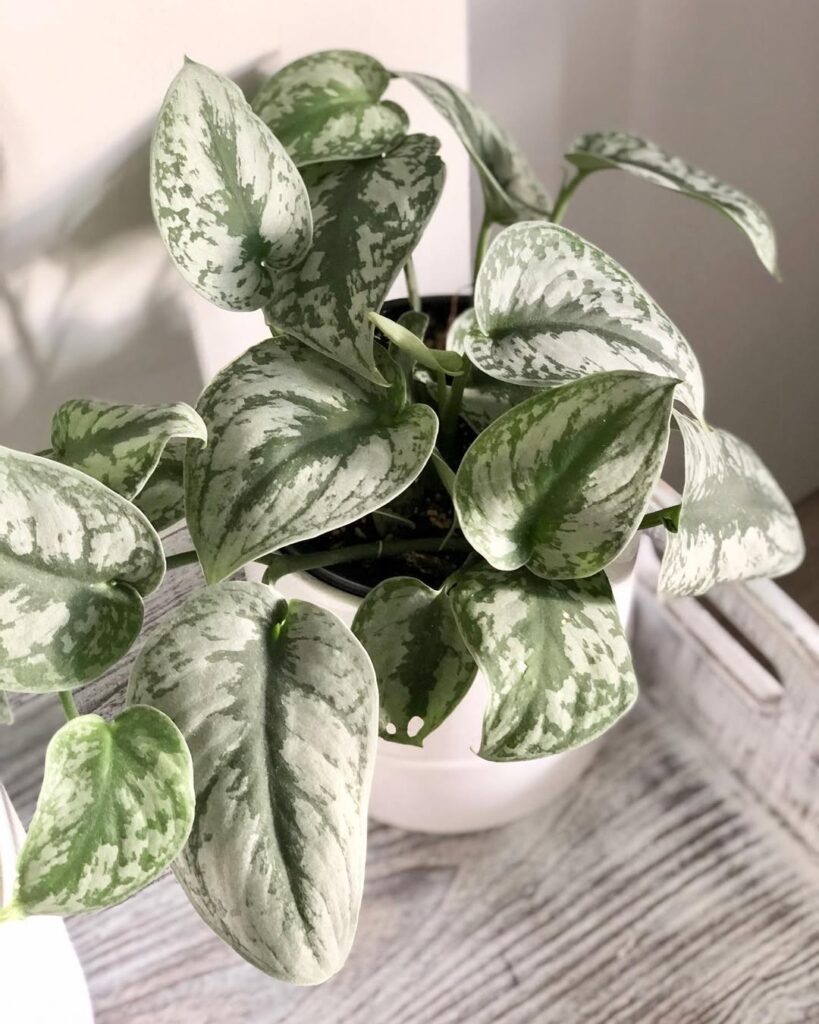
Trebi Pothos, a variation of Scindapsus pictus, is admired for its larger, elongated leaves with silver speckling. It’s slower-growing than standard pothos varieties but rewards patience with stunning foliage that pairs well with other trailing plants.
- Light: Bright to moderate indirect light; silver variegation intensifies under brighter conditions
- Water: Allow soil to dry out slightly between waterings
- Soil: Aroid mix with perlite for aeration
- Humidity: Thrives in higher humidity but adapts to household levels
- Temperature: 65-85°F (18-29°C)
- Support: Can climb with proper support or trail in hanging baskets
- Fertilizer: Light feeding monthly during the growing season
18. Glacier Pothos
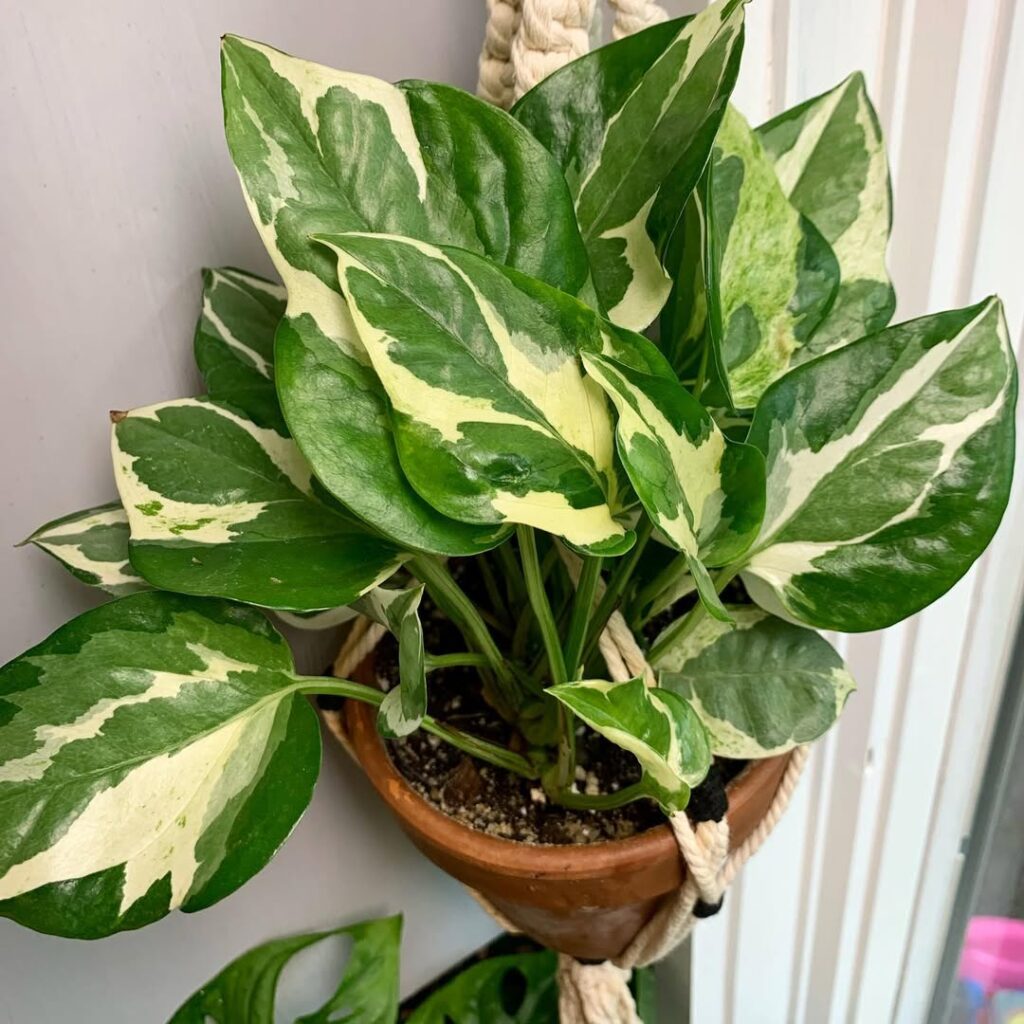
Glacier Pothos is a compact cultivar known for its dainty, white and green variegation. Its small leaves make it an excellent choice for desks or shelves, where it brings an elegant touch without overwhelming the space.
- Light: Bright indirect light enhances variegation; tolerates moderate light
- Water: Let the top inch of soil dry between waterings
- Soil: Well-draining potting mix with peat moss or coco coir
- Humidity: Prefers moderate to high humidity but adjusts well
- Temperature: 65-80°F (18-27°C)
- Support: Trails beautifully but can be trained to climb
- Fertilizer: Monthly feeding with diluted houseplant fertilizer
19. Shangri-La Pothos
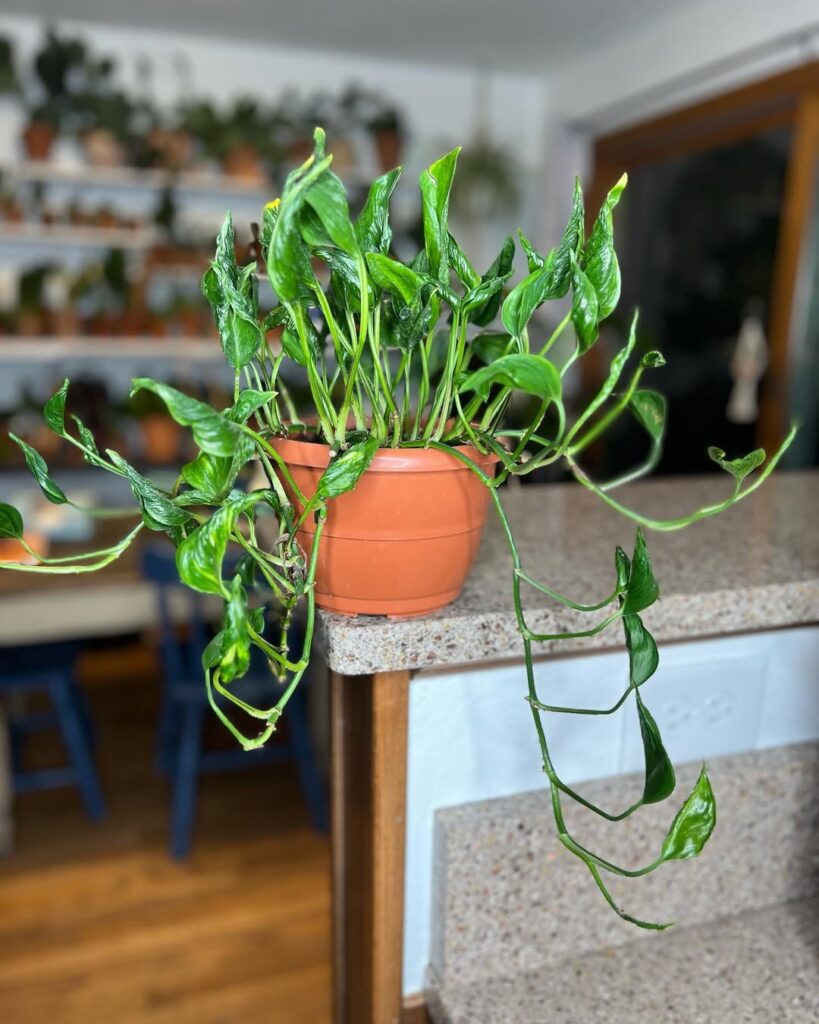
Shangri-La Pothos is a fascinating cultivar with curled, crinkled leaves that make it stand out from traditional pothos varieties. Its compact growth habit and textured foliage add a quirky, unique appeal to indoor gardens.
- Light: Moderate to bright indirect light
- Water: Keep soil slightly moist but avoid waterlogging
- Soil: Well-draining mix with perlite and orchid bark
- Humidity: Benefits from higher humidity levels (50-60%)
- Temperature: 65-85°F (18-29°C)
- Support: Can trail or climb; slow-growing compared to standard pothos
- Fertilizer: Balanced houseplant fertilizer every four weeks
